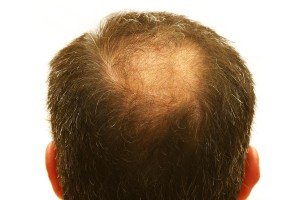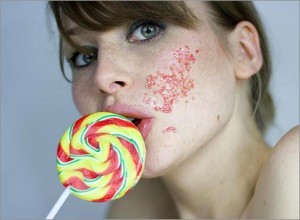It is good to know that there is help for hair loss. One area where aging shows is the head! Often people who are aging are experiencing hair loss. Some individuals have a genetic trait that makes them vulnerable to early hair loss, while others are keeping their hair until a ripe old age. With regard to hair pigment it is similar: some people keep their own hair color well into their 40’s or 50’s, but later the grey hair shows. Loss of hair color is about loss of hair pigment. One or more genes regulate whether or not we lose the hair pigment early or not. While there is not much we can do about our hair pigment other than coloring our hair every 3-4 weeks, there is something we can do about hair loss on our scalp.
Androgenic alopecia
Physicians call male and female hair loss “androgenetic alopecia”. It occurs in individuals who are genetically exposed. Interestingly baldness is rare in Chinese, Japanese and in Native American populations. Baldness more commonly affects men of Caucasian descent.
Onset of hair loss
In people who are prone to hair loss baldness typically starts in the temporal areas.
The genetic factors that lead to baldness can be inherited either from father or mother’s side. They are polygenic, meaning that there is not only one cause of hair loss. Gene frequency is most commonly associated with Caucasians. In Africans the frequency is lower and lower still in American Indians, Asians, and the Inuits.
Types of hair loss
The Norwood scale is used as classification of hair loss in men. In women hair loss is classified using the Ludwig and Savin scale. This helps to record the findings of a hair examination and is useful for research purposes as well.
Hormonal factors regarding male pattern baldness
There are several hormonal factors that are involved in the development of male pattern baldness. 5-alpha reductase converts testosterone (T) to dihydrotestosterone (DHT). DHT is more powerful than testosterone, causes shortening of the hair cycle and miniaturization of hair in the balding areas. After several years those who have genetically predisposed androgen receptors in balding areas come down with baldness. There are two isoenzymes of 5-alpha reductase, type 1 and type 2. Individuals born without type 2 5-alpha reductase do not develop androgenic baldness.
Aromatase can cause baldness
Another factor for baldness can be an enzyme, aromatase, located in the fatty tissue that converts testosterone into estrogenic hormones. A lack of testosterone can lead to baldness by this mechanism. Many men in their 50’s and 60’s who are overweight or obese are balding because of this mechanism. The other mechanism, as explained above is via DHT in genetically susceptible men. This process starts to occur mostly in individuals who are in their forties.
Treatment of hair loss
Mild cases of hair loss
This may respond to topical treatment with minoxidil that can be used on the scalp as liquid or hair foam. Systemic treatment in men is possible with finasteride (Propecia) or Dutasteride (Avodart). It helps to block the hormonal pathways regarding 5-alpha reductase and DHT that leads to baldness. In aging men in their 50’s and 60’s it may be that testosterone levels are low. Blood tests can test for this: the total testosterone level should be above 500 ng/dL. If it is less, testosterone replacement by bioidentical testosterone cream or by injection should be considered and usually works quite well with respect to regrowth of scalp and body hair.
Moderately severe hair loss
This can be treated with PRP (platelet rich plasma). This treatment modality cures about 30% of hair loss. There have to be enough hair-rejuvenating stem cells around the bald skin to stimulate hair growth. However, when baldness has set in for some time in an area of the scalp with previous hair growth, there comes a point where the hair follicles die off and even stimulation with PRP will not help. When dermatologists used extracellular matrix (called “A cell”) in combination with PRP the success rate for hair growth in a bald area jumps up to 70 to 80%. The A cell material recruits stem cells from the blood that create hair follicles in the bald skin starting hair growth again.
Severe hair loss
A cell and PRP treatment are not sufficient for this. It requires more invasive treatment: the bald skin usually does not contain any hair follicles. So, what can one do in such cases? Dermatologists detected that dense hair from the back of the head (nuchal area) is transplantable to a bald skin area. It will usually grow very well there. In the beginning of doing hair transplants little discs were transplanted and this looked at times like checkered hair growth in the previously bald area. Newer research showed that miniaturized transplants with perhaps three hair follicles harvested under the microscope from the dense area and transplanted into the bald area give a smooth, natural looking appearance. These are “follicular unit hair transplants”. Nowadays hair transplant physicians will only do this type of hair transplant procedure because of the superior cosmetic result.
Conclusion
Baldness is no longer a stigma in today’s society, particularly with males. So many men just shave off whatever hair they still have and live with baldness. However, other men and women want something done about the bald scalp; they can do so in various stages, first treat topically with minoxidil, then by trying PRP or PRP with the A cell treatment. Finally follicular unit hair transplants can restore a full head of hair where there was baldness before. In women with crown baldness follicular unit hair transplants can be very useful. This elegant method gets rid of this annoying crown baldness, and women who went for this procedure seem to be very happy with the results.
More info on hair restoration.
More info on hair loss.
References
Ref. 1: Hair disorders, from: “Lookingbill and Marks’ Principles of Dermatology” Fifth Edition: James G. Marks MD and Jeffrey J. Miller MD, Copyright © 2013, Elsevier Inc.







